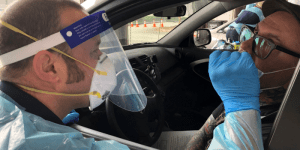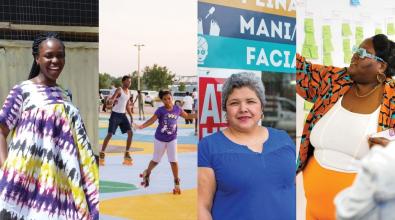How human-centered design helped Seattle double down on COVID testing

When Leah Tivoli found out that she would be part of the team rolling out a massive scale-up of Seattle’s COVID-19 testing capacity, she knew exactly what she needed to do first: Go get a test herself.
She wanted to see how it works — not just the drive-through process, but how it all actually feels as a person who’s never done this before and might be a little intimidated by it.
It was “absolutely terrifying,” she said.
“The site was inside a dark parking garage in an industrial area,” Tivoli recalled. “And I have no sense of direction, so I’m circling around, and finally find it — all these people in full PPE, and I feel so awkward. Am I in the right place? There were signs everywhere, but it was still unclear.
“One sign said to roll down your window two inches. And I’m not only terrified at the test, but I don’t want these people who deal with COVID getting near me. And they pass the swab through the window — it was a site where you have to do the swab yourself. And all I could think is: I’m not qualified to do this. I stick this swab way up in my nose, and turn it for 10 seconds, and then pull it out like a piece of spaghetti, and put it all the way up the other nostril. It was a horrible, horrible experience. I feel like I know what E.T. felt like.”
Tivoli is a manager with Seattle’s innovation team, a group within the city’s budget office funded by Bloomberg Philanthropies. She’s been trained in the ways of human-centered design. And so for her role in the project — designing the front-end customer interface of the testing operation — she wanted to make sure everything was tailored around the needs of the people going to get tested. And the best way to do that was to understand what it would be like from their perspective, a cornerstone of human-centered design.
The result is one of the bright spots in the nation’s otherwise spotty record with COVID-19 testing. Working in close collaboration with a number of public- and private-sector partners, the Seattle team essentially doubled the city’s testing capacity in two weeks, bringing online last month two new locations that can each test 700 people a day, six days a week.
What Tivoli is most excited about is the customer feedback so far — a parade of five-star reviews indicating that Seattle residents appreciate the attention to detail that went into the effort. “Most people have never been to a COVID-19 testing site, so it’s a first-time experience for almost everybody coming through,” Tivoli said. “I’m obsessed with the reviews, because we need to see social acceptance of testing. It needs to become a very normal, accepted thing to do as we try to reopen the economy.”
Tivoli outlined several other innovations in Seattle’s new testing sites that other cities may find useful as they scale up and refine their testing strategies.
Choose locations wisely. Nobody wants a high-volume COVID-19 test site in their neighborhood. Seattle was able to avoid a backlash by taking advantage of two automobile emissions-testing locations that the state of Washington shut down last year. They were ready-built for the drive-through service model. And they met the public health need to bolster testing in parts of the city where data showed it to be lagging. “They were perfect sites,” Tivoli said. “They were already set up for five lanes of traffic. We didn’t have to make any kind of improvements.”
Equity was also a big consideration, and seen within the broader context of testing locations across the city. Previously, most of the sites were in smaller-scale neighborhood-based locations, like a mobile clinic stationed in the city’s most racially and ethnically diverse neighborhood, Rainier Beach. Tivoli said the new locations build up a strong backbone of testing capacity while keeping the neighborhood sites as good alternatives. “Ours is government run, and a lot of people don’t trust the government, especially now. It’s good to have a mix of testing sites in the ecosystem.”
[Read our explainer on human-centered design]
Start small and scale up. Seattle’s goal was to test 1,400 people a day at the new sites. Instead of opening the floodgates immediately, they started with just a small fraction of that, then ramped it up to 300 a day, and then went to full throttle once it was clear their workflow could handle it. One fear was what some cities have seen with COVID-19 testing: Setting up locations only to see very few people show up. “Our worst fear was we would set this up and nobody would show up,” Tivoli said. “The minute we launched, it just filled up immediately.” One reason was that the launch coincided with the beginning of last month’s Black Lives Matter marches, when there was a lot of press attention about the importance of demonstrators getting tested for COVID-19.
Make signup easy. To sign up for a test, residents go to a page on the city’s website that lays out everything they need to know, in seven languages. They click through to an easy-to-use online booking tool that Tivoli customized with volunteer tech support from the upstart group U.S. Digital Response.
The signup process doesn’t just help users book an appointment. It also helps with critical aspects of administration and workflow. One feature is that anyone who has health insurance can simply snap a photo of their insurance card to enter that information — revenue from insurance reimbursement is vital to sustaining the whole enterprise as a free service. The booking tool also regulates the flow of patients so that long lines don’t develop at the testing sites.
“When you’re at the sites, they look empty,” Tivoli said. “That’s because the flow of people coming in is about equal to the flow of people coming out. People get there and they’re like, ‘Oh, there’s no one here’. Meanwhile, we’re processing about 700 people per day.”
To accommodate residents who don’t have internet access, Tivoli partnered with the city’s Customer Service Bureau to create a pathway to sign up for testing over the telephone. About 200 calls a day come in a day, including about 50 from people who need help getting registered. “From an equity lens, that’s really important,” Tivoli said.
Take care of people. One of Tivoli’s biggest revelations from her first visit to get tested is that it can be a scary experience for people who, apart from feeling nervous about the test, may also be anxious about the possibility of being sick with a life-threatening illness. Instead of using self-administered tests, she tapped firefighters and EMTs.
“There’s some data suggesting the tests are more accurate when you have the provider do the test for you,” Tivoli said. “But beyond that, having someone take care of you when you’re feeling vulnerable is very important.”
The sites were designed for emotion — because emotion drives behavior — and “the primary emotion people feel coming to get a COVID test is fear,” Tivoli said. From the staff managing traffic flow to the firefighters and EMTs conducting the testing, everyone working at the sites has been trained to think about how to make people feel welcome and comfortable. “Everyone’s scared — everybody. So being extremely empathetic to how people are feeling is really important.”
Get customer feedback. After patients visit, they get a text message asking them to rate their experience. The feedback so far has been overwhelmingly positive. One day last week, Tivoli scrolled through ratings from the day before — all of them 5-stars, the highest rating — and read through the comments. “Efficient, friendly and calming.” “Not the most pleasant procedure, but the EMT explained everything to ease my apprehension.” “I came 10 minutes early and was done before my scheduled appointment.”
The comments aren’t public, but Tivoli shares it all with staff at the testing centers. “It’s very motivating to get 5 stars and that positive cycle of real-time feedback,” she said. “We’re processing 700 people a day at each site, so how do you keep motivation up to treat each person like they’re unique?”
Partnerships are critical. Many partners are involved in making Seattle’s testing operation a success. University of Washington Medicine brought the test infrastructure and handles billing insurance; Seattle King County made sure the operation qualifies for federal reimbursement; U.S. Digital Response helped with the technology setup, using pre-built booking software from a company called Solv.
Two weeks in, Seattle’s testing sites are each seeing just a little more than the expected 700 patients a day. What’s best, Tivoli said, is how many of them are happy customers. “We’re getting feedback from folks saying, ‘I wish all healthcare was like this’ or ‘I wish I could do all my shots this way’. People really like this concept. It really blew my mind.”


